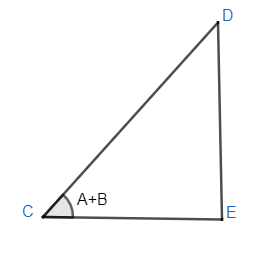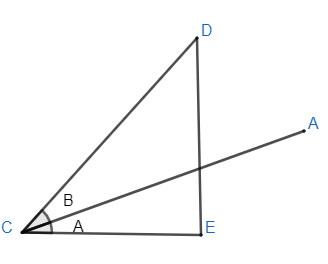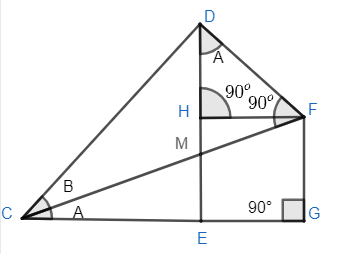Answer
417.9k+ views
Hint: For proving the given relation, take a right angle triangle with one angle as A + B. split this angle to A and B by a line. Draw perpendicular by the vertex of the triangle to the line. Solve it further.
$\sin \theta =\dfrac{\text{Perpendicular}}{\text{Hypotenuse}},cos\theta =\dfrac{\text{Base}}{\text{Hypotenuse}}$
Complete step-by-step answer:
Given in the question is
$\sin \left( A+B \right)=\sin A\cos B+\cos A\sin B....................\left( i \right)$
Let us suppose a right angle with one angle of it as (A + B).

Let us split angle A + B into two angles i.e. A and B. Diagram can be given as

Now, draw a perpendicular to the line AC meeting at F and draw a perpendicular from point F to side ED. So we get diagram as

Where FG is perpendicular to line CE. Now, CE and HF are two lines that are perpendicular to the same line DE. It means CE and HF should be parallel to each because perpendicular to any line will have only one direction. So, $HF||CE$.
Hence, $\angle HFM=A$ because of corresponding angles formed by a transversal with two parallel lines. As we know, the sum of all angles of a triangle is ${{180}^{\circ }}$.
So, in $\Delta FHM$
$\begin{align}
& \angle HFM+\angle FMH+\angle MHF={{180}^{\circ }} \\
& A+\angle FMH+90={{180}^{\circ }} \\
& \angle FMH=90-A............................\left( i \right) \\
\end{align}$
Now, in $\Delta DFM$ , we get
$\angle DFM+\angle FMD+\angle MDF={{180}^{\circ }}$
Using equation (i) we get
\[\begin{align}
& {{90}^{\circ }}+{{90}^{\circ }}-A+\angle MDF={{180}^{\circ }} \\
& \angle MDF=A....................\left( ii \right) \\
\end{align}\]
Now, take $\sin C,\sin \left( A+B \right)$ in $\Delta DCE$ we get
$\begin{align}
& \sin \left( A+B \right)=\dfrac{\text{Perpendicular}}{\text{Hypotaneous}}.....................\left( iii \right) \\
& \sin \left( A+B \right)=\dfrac{DE}{CD}..............................\left( iv \right) \\
\end{align}$
Now, we can write DE as sum of length DH and HE, we get
DE = DH + HE……………………(v)
So, we get from equation (iv) and (v) as
$\begin{align}
& \sin \left( A+B \right)=\dfrac{DH+HE}{CD} \\
& Sin\left( A+B \right)=\dfrac{DH}{CD}+\dfrac{HE}{CD} \\
\end{align}$
Now, multiply and divide the first fraction on RHS by FD and second fraction by CF. So we get value of $\sin \left( A+B \right)$ as
$\begin{align}
& \sin \left( A+B \right)=\dfrac{DH}{CD}\times \dfrac{FD}{FD}+\dfrac{HE}{CD}\times \dfrac{CF}{CF} \\
& \sin \left( A+B \right)=\dfrac{DH}{FD}\times \dfrac{FD}{CD}+\dfrac{HE}{CF}\times \dfrac{CF}{CD}.........................\left( vi \right) \\
\end{align}$
Now from $\Delta DFC$ we get
$\sin B=\dfrac{FD}{CD},\cos B=\dfrac{CF}{CD}$
And from $\Delta DHF$ we get
$\cos A=\dfrac{DH}{FD}$
Similarly, from $\Delta CFG$ we get
$\sin A=\dfrac{FG}{CF}$
As FG = HE, because HFGE is acting as a rectangle, all the angles of HFGE are ${{90}^{\circ }}$ .
So, we can write the value of $\sin A$ as
$\sin A=\dfrac{HE}{CF}$
Now, we can use above relation with the equation (vi) and hence we get
$\begin{align}
& \sin \left( A+B \right)=\cos A\sin B+\sin A\cos B, \\
& \sin \left( A+B \right)=\sin A\cos B+\cos A\sin B \\
\end{align}$
Hence, the given relation is proved. So, the given expression in the problem is true. So, the answer should be 1 as the statement is true.
Note: One may verify the equation by putting some values of A and B. Example: $A={{30}^{\circ }},B={{60}^{\circ }}$. So, it can be another approach for these kinds of questions.
Constructing the diagram mentioned in the solution is the key point for proving the given relation. One may prove the relation of $\tan \left( A+B \right),\sin \left( A-B \right),\cos \left( A+B \right)$.
As well with the same approach.
$\sin \theta =\dfrac{\text{Perpendicular}}{\text{Hypotenuse}},cos\theta =\dfrac{\text{Base}}{\text{Hypotenuse}}$
Complete step-by-step answer:
Given in the question is
$\sin \left( A+B \right)=\sin A\cos B+\cos A\sin B....................\left( i \right)$
Let us suppose a right angle with one angle of it as (A + B).

Let us split angle A + B into two angles i.e. A and B. Diagram can be given as

Now, draw a perpendicular to the line AC meeting at F and draw a perpendicular from point F to side ED. So we get diagram as

Where FG is perpendicular to line CE. Now, CE and HF are two lines that are perpendicular to the same line DE. It means CE and HF should be parallel to each because perpendicular to any line will have only one direction. So, $HF||CE$.
Hence, $\angle HFM=A$ because of corresponding angles formed by a transversal with two parallel lines. As we know, the sum of all angles of a triangle is ${{180}^{\circ }}$.
So, in $\Delta FHM$
$\begin{align}
& \angle HFM+\angle FMH+\angle MHF={{180}^{\circ }} \\
& A+\angle FMH+90={{180}^{\circ }} \\
& \angle FMH=90-A............................\left( i \right) \\
\end{align}$
Now, in $\Delta DFM$ , we get
$\angle DFM+\angle FMD+\angle MDF={{180}^{\circ }}$
Using equation (i) we get
\[\begin{align}
& {{90}^{\circ }}+{{90}^{\circ }}-A+\angle MDF={{180}^{\circ }} \\
& \angle MDF=A....................\left( ii \right) \\
\end{align}\]
Now, take $\sin C,\sin \left( A+B \right)$ in $\Delta DCE$ we get
$\begin{align}
& \sin \left( A+B \right)=\dfrac{\text{Perpendicular}}{\text{Hypotaneous}}.....................\left( iii \right) \\
& \sin \left( A+B \right)=\dfrac{DE}{CD}..............................\left( iv \right) \\
\end{align}$
Now, we can write DE as sum of length DH and HE, we get
DE = DH + HE……………………(v)
So, we get from equation (iv) and (v) as
$\begin{align}
& \sin \left( A+B \right)=\dfrac{DH+HE}{CD} \\
& Sin\left( A+B \right)=\dfrac{DH}{CD}+\dfrac{HE}{CD} \\
\end{align}$
Now, multiply and divide the first fraction on RHS by FD and second fraction by CF. So we get value of $\sin \left( A+B \right)$ as
$\begin{align}
& \sin \left( A+B \right)=\dfrac{DH}{CD}\times \dfrac{FD}{FD}+\dfrac{HE}{CD}\times \dfrac{CF}{CF} \\
& \sin \left( A+B \right)=\dfrac{DH}{FD}\times \dfrac{FD}{CD}+\dfrac{HE}{CF}\times \dfrac{CF}{CD}.........................\left( vi \right) \\
\end{align}$
Now from $\Delta DFC$ we get
$\sin B=\dfrac{FD}{CD},\cos B=\dfrac{CF}{CD}$
And from $\Delta DHF$ we get
$\cos A=\dfrac{DH}{FD}$
Similarly, from $\Delta CFG$ we get
$\sin A=\dfrac{FG}{CF}$
As FG = HE, because HFGE is acting as a rectangle, all the angles of HFGE are ${{90}^{\circ }}$ .
So, we can write the value of $\sin A$ as
$\sin A=\dfrac{HE}{CF}$
Now, we can use above relation with the equation (vi) and hence we get
$\begin{align}
& \sin \left( A+B \right)=\cos A\sin B+\sin A\cos B, \\
& \sin \left( A+B \right)=\sin A\cos B+\cos A\sin B \\
\end{align}$
Hence, the given relation is proved. So, the given expression in the problem is true. So, the answer should be 1 as the statement is true.
Note: One may verify the equation by putting some values of A and B. Example: $A={{30}^{\circ }},B={{60}^{\circ }}$. So, it can be another approach for these kinds of questions.
Constructing the diagram mentioned in the solution is the key point for proving the given relation. One may prove the relation of $\tan \left( A+B \right),\sin \left( A-B \right),\cos \left( A+B \right)$.
As well with the same approach.
Recently Updated Pages
Assertion The resistivity of a semiconductor increases class 13 physics CBSE

The Equation xxx + 2 is Satisfied when x is Equal to Class 10 Maths

How do you arrange NH4 + BF3 H2O C2H2 in increasing class 11 chemistry CBSE

Is H mCT and q mCT the same thing If so which is more class 11 chemistry CBSE

What are the possible quantum number for the last outermost class 11 chemistry CBSE

Is C2 paramagnetic or diamagnetic class 11 chemistry CBSE

Trending doubts
Difference Between Plant Cell and Animal Cell

Difference between Prokaryotic cell and Eukaryotic class 11 biology CBSE

Fill the blanks with the suitable prepositions 1 The class 9 english CBSE

Change the following sentences into negative and interrogative class 10 english CBSE

Summary of the poem Where the Mind is Without Fear class 8 english CBSE

Give 10 examples for herbs , shrubs , climbers , creepers

Write an application to the principal requesting five class 10 english CBSE

What organs are located on the left side of your body class 11 biology CBSE

What is the z value for a 90 95 and 99 percent confidence class 11 maths CBSE



